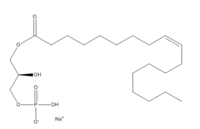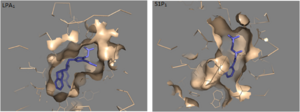Sandbox Reserved 1175
From Proteopedia
(Difference between revisions)
| Line 2: | Line 2: | ||
==Human ''Lysophosphatodic Acid'' Receptor 1== | ==Human ''Lysophosphatodic Acid'' Receptor 1== | ||
| - | <StructureSection load='4z34' size='340' side='right' caption='LPA' scene=''> | ||
==Lysophosphatodic Acid== | ==Lysophosphatodic Acid== | ||
| Line 9: | Line 8: | ||
==Function== | ==Function== | ||
LPA, a signaling phospholipid, can attach to three specific G-protein-coupled receptors. LPA can activate multiple pathways in particular, Ras and Pho which belong to the family of GTPases. Another use of LPA is it can help in stimulation of cell migration <ref name="Moolenaar"> DOI: 10.1002/bies.20081 </ref>. | LPA, a signaling phospholipid, can attach to three specific G-protein-coupled receptors. LPA can activate multiple pathways in particular, Ras and Pho which belong to the family of GTPases. Another use of LPA is it can help in stimulation of cell migration <ref name="Moolenaar"> DOI: 10.1002/bies.20081 </ref>. | ||
| - | + | ||
<scene name='72/721546/Lpa-helices/1'>Helices</scene> | <scene name='72/721546/Lpa-helices/1'>Helices</scene> | ||
| + | ==Structure== | ||
| + | <StructureSection load='4z34' size='340' side='right' caption='LPA' scene=''> | ||
===Comparison of S1P and LPA=== | ===Comparison of S1P and LPA=== | ||
Lysophosphatidic Acid Receptors (LPA) are part of a larger family known as lysophospholipid receptor family (EDG family). Within this family there is a structure called S1P1. Since only the structures for LPA<sub>1</sub> and S1P<sub>1</sub> are known in the EDG family, comparisons are made between the two structures <ref name= "Chrencik"> PMID: 26091040 </ref>. | Lysophosphatidic Acid Receptors (LPA) are part of a larger family known as lysophospholipid receptor family (EDG family). Within this family there is a structure called S1P1. Since only the structures for LPA<sub>1</sub> and S1P<sub>1</sub> are known in the EDG family, comparisons are made between the two structures <ref name= "Chrencik"> PMID: 26091040 </ref>. | ||
Revision as of 11:59, 29 March 2016
| This Sandbox is Reserved from Jan 11 through August 12, 2016 for use in the course CH462 Central Metabolism taught by R. Jeremy Johnson at the Butler University, Indianapolis, USA. This reservation includes Sandbox Reserved 1160 through Sandbox Reserved 1184. |
To get started:
More help: Help:Editing |
Contents |
Human Lysophosphatodic Acid Receptor 1
Lysophosphatodic Acid
Function
LPA, a signaling phospholipid, can attach to three specific G-protein-coupled receptors. LPA can activate multiple pathways in particular, Ras and Pho which belong to the family of GTPases. Another use of LPA is it can help in stimulation of cell migration [1].
Structure
| |||||||||||
References
- ↑ 1.0 1.1 1.2 Moolenaar WH, van Meeteren LA, Giepmans BN. The ins and outs of lysophosphatidic acid signaling. Bioessays. 2004 Aug;26(8):870-81. PMID:15273989 doi:http://dx.doi.org/10.1002/bies.20081
- ↑ 2.0 2.1 Chrencik JE, Roth CB, Terakado M, Kurata H, Omi R, Kihara Y, Warshaviak D, Nakade S, Asmar-Rovira G, Mileni M, Mizuno H, Griffith MT, Rodgers C, Han GW, Velasquez J, Chun J, Stevens RC, Hanson MA. Crystal Structure of Antagonist Bound Human Lysophosphatidic Acid Receptor 1. Cell. 2015 Jun 18;161(7):1633-43. doi: 10.1016/j.cell.2015.06.002. PMID:26091040 doi:http://dx.doi.org/10.1016/j.cell.2015.06.002
- ↑ Inoue M, Rashid MH, Fujita R, Contos JJ, Chun J, Ueda H. Initiation of neuropathic pain requires lysophosphatidic acid receptor signaling. Nat Med. 2004 Jul;10(7):712-8. Epub 2004 Jun 13. PMID:15195086 doi:http://dx.doi.org/10.1038/nm1060


